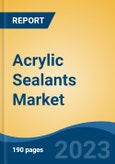Speak directly to the analyst to clarify any post sales queries you may have.
10% Free customizationThis report comes with 10% free customization, enabling you to add data that meets your specific business needs.
The surge in construction and renovation, especially in emerging economies, coupled with a push for sustainable and eco-friendly materials, is boosting market demand. Low-VOC acrylic sealants are increasingly favored for their environmental benefits and ability to improve indoor air quality. Innovation in product performance - such as quicker curing, enhanced flexibility, and durability - has further broadened their applications. Moreover, government investments in public infrastructure projects like roads and buildings are playing a key role in the market’s expansion.
Key Market Drivers
Increased infrastructural and construction activities
The global acrylic sealants market is significantly fueled by the ongoing surge in construction and infrastructure development activities. As urban populations grow, the demand for residential, commercial, and public infrastructure rises, consequently increasing the use of acrylic sealants due to their crucial role in ensuring structural durability and energy efficiency.For example, in India, the pace of National Highway construction soared from 12.1 kilometers per day in 2014-15 to 33.8 kilometers per day in 2023-24, according to the Press Information Bureau (PIB). This growth, paired with a 60% expansion in the national highway network, underscores a major infrastructure initiative aimed at improving connectivity and reducing logistical costs. Rapid urbanization, particularly in emerging and developed economies, has heightened the demand for construction projects, where acrylic sealants are employed to seal joints, gaps, and seams - offering weather resistance, waterproofing, and insulation in building structures.
Key Market Challenges
Volatile raw material prices
One of the key challenges in the global acrylic sealants market is the instability of raw material prices. Acrylic polymers, solvents, and additives form the core of sealant formulations, and fluctuations in their costs can disrupt production economics. These unpredictable variations hinder manufacturers from maintaining consistent pricing, which may influence consumer behavior and affect sales. Moreover, rising raw material costs can compress profit margins, reducing available capital for research, innovation, or product diversification. To mitigate these impacts, manufacturers are increasingly focusing on strategic sourcing, optimizing supply chains, and exploring cost-effective, sustainable alternatives to ensure business continuity and long-term market growth.Key Market Trends
Rising demand for high-performance acrylic sealants
The demand for high-performance acrylic sealants is emerging as a prominent trend, especially across the construction, automotive, and electronics industries. These advanced sealants offer superior adhesion, resilience, and compatibility with challenging conditions like extreme temperatures and chemical exposure. In construction, they provide long-term protection against moisture, UV rays, and weather damage - making them an essential choice for sealing critical structural joints. In the automotive industry, their effectiveness in bonding and sealing vehicle components underlines their growing appeal. As industries place increasing importance on performance and longevity, this trend is propelling consistent demand. Manufacturers are responding by advancing research and development to deliver next-generation sealants that meet stringent quality and durability standards across applications.Key Market Players
- 3M
- American Sealants
- BASF SA
- E. I. du Pont de Nemours and Company
- GE Sealants & Adhesives
- H.B Fuller Company
- Henkel AG & Co. KGaA
- Hodgson Sealants
- Premier Building Solutions
- RPM International, Inc.
- The Dow Chemical Company
Report Scope:
In this report, the Global Acrylic Sealants Market has been segmented into the following categories, in addition to the industry trends which have also been detailed below:Acrylic Sealants Market, By Type:
- Coloured
- Colourless
Acrylic Sealants Market, By Application:
- Building
- Automotive
- Other
Acrylic Sealants Market, By Region:
- Asia-Pacific
- China
- India
- Japan
- Australia
- South Korea
- North America
- United States
- Canada
- Mexico
- Europe
- France
- United Kingdom
- Italy
- Germany
- Spain
- South America
- Brazil
- Argentina
- Colombia
- Middle East & Africa
- South Africa
- Saudi Arabia
- UAE
Competitive Landscape
Company Profiles: Detailed analysis of the major companies present in the Global Acrylic Sealants Market.Available Customizations:
With the given market data, the publisher offers customizations according to a company's specific needs. The following customization options are available for the report.Company Information
- Detailed analysis and profiling of additional market players (up to five).
This product will be delivered within 1-3 business days.
Table of Contents
Companies Mentioned
- 3M
- American Sealants
- BASF SA
- E. I. du Pont de Nemours and Company
- GE Sealants & Adhesives
- H.B Fuller Company
- Henkel AG & Co. KGaA
- Hodgson Sealants
- Premier Building Solutions
- RPM International, Inc.
- The Dow Chemical Company
Table Information
| Report Attribute | Details |
|---|---|
| No. of Pages | 185 |
| Published | June 2025 |
| Forecast Period | 2024 - 2030 |
| Estimated Market Value ( USD | $ 0.91 Billion |
| Forecasted Market Value ( USD | $ 1.23 Billion |
| Compound Annual Growth Rate | 5.1% |
| Regions Covered | Global |
| No. of Companies Mentioned | 11 |









